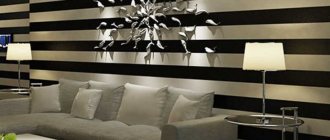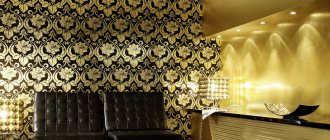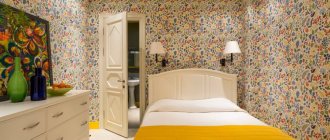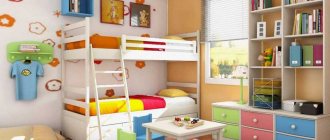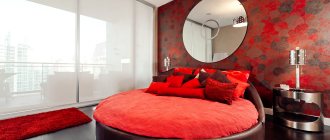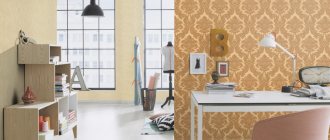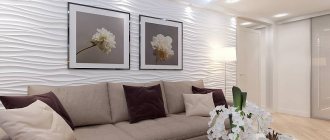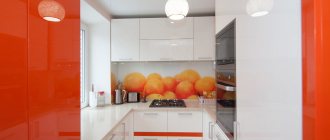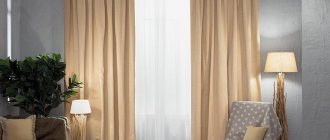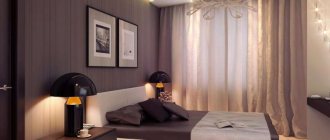Main features of using wallpaper in the interior of an apartment
When gluing any wallpaper, it is important to take into account that they are glued “overlapping” from the window to the far wall - this way the joints do not cast a shadow. When gluing from the center of the wall, symmetry is maintained, which is most important if the pattern is large. Butt gluing requires extreme precision and perfectly smooth walls.
Wallpaper for walls is the simplest and one of the most effective options for decorating the inside of a house.
The more spacious the room, the larger the pattern on the wallpaper is acceptable. In large rooms it is allowed to glue several types of canvases that match each other. Bright photo wallpapers are used to decorate only one wall, preferably completely free, near which there is no furniture or decor.
In a one-room
The best wallpaper for a one-room apartment is selected based on its orientation in space. When the windows are narrow and face north, the coating acquires a glossy, light, warm shade. If the windows are large, facing south. Then relatively dark wallpapers of cool colors are acceptable.
Among the huge selection of colors, textures and various effects, you can find exactly what will reflect the interests and mood of the owners of the house.
In a studio apartment
The design of suitable wallpaper for a studio apartment, shown in the photo, depends on the area of the room. A cramped apartment is covered with light, warm, plain canvases, while a more spacious one is covered with products with large patterns.
The ability to color and combine different materials allows you to create a completely unique design.
In a two-room apartment, a three-room apartment, a multi-room apartment
When there are two or more rooms in an apartment, they are decorated completely differently. For each room, different colors, designs, and textures of coatings are purchased. An equally popular option is that the entire home is designed in the same style, the walls have a similar design, but differ in color.
Wallpaper is the most common method of finishing walls in residential premises.
Classification of wallpaper for the living room, photo
When choosing modern wallpaper for a living room, buyers first of all pay attention to color schemes, patterns or textures. However, this factor is far from the most important. First of all, you should determine the type of product. Unlike the kitchen or hallway, there are no special performance requirements for the finishing materials used in the living room. There is no high humidity in the hall combined with high temperature and aggressive environment, no strong strong odors, no condensation. Therefore, wallpaper for the living room wall can be made from almost any material.
Paper
Despite their affordable price, their market share is rapidly declining. First of all, this is due to significant limitations in operation, as well as the need to ideally prepare the base surface. Even two-layer paper wallpaper easily reveals any defects on the working surface. Suitable for use only in rooms with normal humidity - up to 70%. The maximum service life does not exceed 4-5 years, and if there are small children or animals in the apartment, then 1.5-2 years.
An example of using paper wallpaper in a living room interior:
PHOTO: eremontbp.com
PHOTO: eremontbp.com
PHOTO: eremontbp.com
PHOTO: eremontbp.com
Related article:
Wallpaper for walls: catalog of photos of interesting solutions for the living room, bedroom, children's room, kitchen and corridor. Read our review for basic rules for selecting canvases and designers’ recommendations.
Polymer based wallpaper
Experts classify vinyl and non-woven wallpaper as one class of finishing materials. They are characterized by high strength and durability, as well as a wide color palette and the presence of textured solutions. Non-woven wallpaper can be repainted several times, periodically updating the interior without significant financial costs. Wet cleaning with the use of cleaning products is allowed, which preserves the aesthetic qualities of the finish for a long time.
Vinyl wallpaper in the living room interior:
PHOTO: eremontbp.com
PHOTO: eremontbp.com
PHOTO: eremontbp.com
PHOTO: eremontbp.com
Advice! Vinyl and non-woven wallpaper with deep embossing can hide significant defects in the base.
Related article:
How to glue vinyl wallpaper on paper. The secrets of high-quality gluing of vinyl sheets on paper are in a separate publication on our portal.
Textile
This is wallpaper based on natural fibers:
- linen;
- cotton;
- silk.
They are made by attaching natural fabric to a non-woven or cellulose base. On the finishing materials market you can purchase textile wallpapers with jute, velor or felt textures. This finish is ideal for decorating a room in a classic style. It adds sophistication and sophistication to the interior of the room.
Exquisite textile wallpaper for a living room in a private house, photos of interiors:
PHOTO: eremontbp.com
PHOTO: eremontbp.com
PHOTO: eremontbp.com
PHOTO: eremontbp.com
Metallized
Metallized or foil wallpaper also consists of two layers: a paper base and an outer decorative layer of thin metal foil. As a rule, gold, silver, pearl, mother-of-pearl or bronze color and texture combinations prevail in the decor. This finishing is used to focus attention on individual interior elements.
Metallized wallpaper is usually used to decorate individual building structures and interior elements:
PHOTO: eremontbp.com
PHOTO: eremontbp.com
PHOTO: eremontbp.com
PHOTO: eremontbp.com
Photo wallpaper
Photo wallpaper on the wall in the living room has gained wide popularity due to the wide possibilities for visual correction of the dimensions of the room. Thanks to the wide range of commercially available themes, you can either visually expand the room by giving it greater height, or visually reduce it by bringing a distant wall closer, highlighting individual functional areas, etc. Photo wallpapers can be either paper, non-woven or vinyl based. Recently, many technologies for applying images have appeared, and their detail and quality have also increased significantly. Particularly notable are 3D prints, which have radically changed the approach to the design of a room with photo wallpaper. To preserve the image in its original form, a special film or varnish is applied to the surface of the photo wallpaper.
Photo wallpaper in the hall photo interiors:
PHOTO: eremontbp.com
PHOTO: eremontbp.com PHOTO: eremontbp.com
PHOTO: eremontbp.com
PHOTO: eremontbp.com
PHOTO: eremontbp.com
Related article:
Photo wallpaper that expands space. In a separate publication, we will tell you how to choose and use photo wallpaper with three-dimensional designs for small rooms.
Glass wallpaper
The principle of manufacturing such finishing is in many ways similar to textile wallpaper materials. Glass threads produced using a special technology are used as fibers. They are attached to a paper or non-woven base. This finishing material has an attractive appearance and original texture. In addition, glass wallpaper does not burn, and its melting point is +500ºС. The high cost is compensated by a significant service life - up to 25 years.
Designers are developing very original prints for glass wallpaper:
PHOTO: noviydom.com.ua
PHOTO: noviydom.com.ua PHOTO: tvoidvor.com
PHOTO: tvoidvor.com
Table 1. Advantages and disadvantages of wallpaper for the living room
| Material of manufacture | Advantages | Flaws |
| Paper | Cheapness; ease of gluing; wide choice of colors and patterns | Not durable; afraid of mechanical influences; cannot tolerate high humidity; are not cleaned; burn out over time; exhibit foundation defects |
| Vinyl | High strength; relief texture; moisture resistance; washing using household chemicals is allowed; high decorative indicators; hide significant base defects | High price; vapor tightness; have a characteristic odor that lasts quite a long time after gluing; the material is heavy and requires special glue; quite difficult to stick on your own |
| Nonwoven | Reasonable cost; good vapor permeability; easy to clean from dirt; withstands wet cleaning; are painted, depending on the relief, from 3 to 5 times; hide small base defects | Limited range of textures; require special glue; require mandatory painting |
| Acrylic | Vapor permeable; non-marking (dust-repellent effect); biologically neutral; withstands light wet cleaning using household detergents | Limited range of colors and textures; Pasting is not allowed in rooms with high humidity |
| Textile | Environmental neutral; natural materials are used as raw materials; have a sound and heat insulation effect; there is no obvious joining of the canvases; high decorative performance | Very high cost; gluing can only be carried out by a professional; absorb odors; become electrified and attract dust; dry clean only |
| Metallized | High parameters of sound and heat insulation; have a protective effect against electromagnetic radiation; wet cleaning using household chemicals is allowed | Vapor-tight; sensitive to mechanical stress; create minor interference with Wi-Fi and mobile communications |
| Liquid | There are no seams or joints; do not fade from sunlight; simple application technology (you can do it yourself); high noise insulation effect; very easy to repair | Relatively high cost; wet cleaning is not allowed; limited choice of decorative solutions |
| Photo wallpaper | Wide range of images; you can find the most original themes that harmonize with any type of interior; affordable price | Very careful gluing work is required, which is best left to professionals; show wall defects; cleaning should be done very carefully |
| Glass wallpaper | Environmental friendliness; long service life; original design; fire resistance; easy to care for | Extremely high cost; limited color palette |
Related article:
Stereoscopic wallpaper : price, features, advantages, disadvantages, varieties, secrets of choice, average prices, how exactly the stereo effect is created - read our review.
Video: how to choose and combine wallpaper correctly
Types for interior decoration
Photos of interiors with wallpaper in ordinary apartments show a huge variety of textures, materials, and patterns. There are paper and non-woven, fabric or fiberglass, liquid and bamboo, vinyl and cork, acrylic and magnetic.
Paper
There are laminated, simplex, duplex. Usually they are glued in living rooms. There are moisture-resistant foam wallpapers that can mask minor wall defects.
Budget type of wall decoration with a large selection of colors and patterns.
Non-woven
This material is very durable, breathable, and looks great in any room. The coating easily hides small cracks and irregularities.
Vinyl
Vinyl is not afraid of water and usually has a characteristic shine. They can be used for covering bathrooms, toilets, and kitchen work areas.
This popular type of wallpaper for walls is durable and strong.
Photo wallpaper
The most beautiful type of coating. They are printed on a special printer, the most popular options are those with 3D images.
Fabric
Textile and paper material has an interesting texture of fabric and lace. The main disadvantage is that high-quality gluing is only possible on a well-leveled wall.
The material has a base and an upper textile covering, which can be made of different materials.
Glass wallpaper
The base is a woven material with the addition of the finest glass fibers. The coating is durable, fireproof, and can be painted.
Bamboo
Completely natural, but expensive material. It looks impressive, has a unique design, and is suitable for decorating an ecological, ethnic interior.
The materials are, first of all, environmentally friendly, resistant to changes in humidity and temperature.
Liquid
They look like a dry mixture diluted with water. It is applied with a spatula, much like plaster, without forming seams.
Types of wallpaper raw materials
The first people to use wallpaper on walls were in ancient China; for this they used bright canvases of painted paper. Subsequently, decorating the walls of a room with paper spread throughout the world. But wallpaper got its name in Europe.
The materials from which wallpaper is made are constantly being improved, and the construction market never ceases to delight consumers with new, original wallpaper products. Its quality differs in the following ways:
- base and top coat;
- performance properties;
- structure of the material;
- number of layers.
Combining a paper base with a coating is by far the most popular type of wallpaper. This is due to the reasonable price and ease of use; natural raw materials are also an important factor.
The absence of films like vinyl or non-woven wallpaper makes paper wallpaper a preferable option for the bedroom and nursery, thanks to its breathable surface.
Improved paper products meet all the requirements for quality standards, and a variety of bright colors and original texture options make them competitive.
Fashionable solutions, combinations of wallpaper colors with the interior of the floor and ceiling in the apartment
According to the design rules, the floor is made the darkest, creating good support for human feet and furniture. The preferred color for the walls is two or three shades lighter, and the ceiling is as light as possible.
Bright hues
Light-colored canvases are preferable for cramped, northern, northwestern rooms. The most popular two-color combinations:
- snow-white with gray;
- cream with yellow-orange;
- salmon with peach;
- lime with olive;
- bluish white with sky blue.
Construction stores offer an incredible variety of colors, textures and materials.
Tip: warm, light options can slightly expand the room.
Dark colors
Dark options are suitable for spacious apartments with windows facing south, as they visually reduce the space. Best combinations:
- emerald with azure;
- blue-black with burgundy;
- lilac-blue with steel;
- black-brown with graphite gray;
- terracotta with chrome green.
A large assortment allows you to choose the ideal option taking into account the characteristics of the apartment.
Planning future renovations: basic rules
Are your projects for the future to completely renovate your apartment? Then stock up on enough free time; it is advisable to be on vacation during the entire process. Coordinate the design style or color choice of room wallpaper with all family members, especially children, for a child's room remodel. Following simple rules, outline an algorithm for your actions:
- Draw a plan of all the rooms on a piece of paper, with the arrangement of furniture and the selection of a color scheme that matches the color of the furniture. This will help avoid color mistakes in the future;
- Create a convenient zoning of the premises, highlighting a recreation area, an area for games and the location of guests. This can be achieved by arranging furniture, arranging partitions and niches, visually delimiting the space;
When renovating, you should remember some design moves, for example, vertical striped wallpaper will make the room visually taller - Clearly calculate the amount of consumables in the estimate, since if there is a shortage, problems may arise in selecting the desired color or texture. This will also help you find out the amount of finance needed;
- Painting the walls will not solve problems with the appearance if the plaster has crumbled and requires redoing. Save your time and money to be satisfied with the result and not have to redo everything again.
Attention! Remember that electrical wiring and gas equipment should only be installed by experienced specialists to avoid negative consequences.
Wall design in the interior of different rooms
Suitable wallpaper for a modern studio is plain. In an apartment where only the bathroom is separated by a wall, they use one main type of covering, supplementing it with small accent spots.
Living room
Wallpaper for the hall - luxurious, high-quality, original. The living room is usually the largest room in the house, so a large picture is acceptable. In the hall combined with the kitchen, zoning is done using wall coverings, complementing the delimitation with furniture.
The hall can be decorated with either one type of wallpaper or different materials.
Bedroom
For the bedroom, a calm color scheme is preferable. Opposite the bed it is permissible to place 3D photo wallpapers on a natural theme.
The decoration of the bedroom can be done in different ways: with photo wallpaper, completely in one color, highlighting the sleeping area.
Hallway
Wear-resistant, washable, non-staining coating options are purchased for the corridor. They should go well with the design of the doors leading from the hallway to the rooms.
For the walls of a closed hallway or with low lighting, you should use a light color of wallpaper.
Kitchen
The kitchen design is waterproof, bright, and made in “appetizing” colors. Coffee themes, images of fruits, berries, and vegetables are ideal.
The color of the walls should be combined with the kitchen set; these can be harmonizing shades or a similar color in the elements.
Children's
Paintable or washable wallpaper is used in the children's room, since children often draw on the walls. Suitable design - cartoon characters, fairy tales, teddy bears, hares, cats.
In a child’s room, a good idea would be photo wallpapers, options with playful pictures or just different colors.
Cabinet
Wall decor is as strict, neutral, and unobtrusive as possible. Nothing should distract a person working at a computer or desk from important matters.
The design should not be distracting or provocative; a simple ornament will be enough.
slate wall
Are you a lover of original ideas? Want more creativity in your home interior? Then this type of decor will definitely be interesting for you. Just imagine, in your kitchen, hallway or living room there can be a new drawing on the wall every day. Quite unusual, isn't it? To do this, you just need to hang a chalkboard or paint the wall with chalkboard paint. Believe me, this idea will be appreciated not only by adults, but also by your children, who will be happy to “update” the interior every day.
Drawings, various slogans, poems, quotes - all this will look just great on the wall. What if you write words of love to your household while leaving for work? It will bring them so much joy. Good mood for the whole day is guaranteed. The slate wall also has practical benefits. It is very convenient to write plans for the day, recipes or grocery lists. It will also become indispensable for activities with children. The price of this type of finishing is quite small, which will certainly please everyone.
Fashionable, modern interior styles, combined with wallpaper on the walls
In the photo, original and beautiful wallpaper on the walls in the apartment is selected for a specific interior. This coating is appropriate for avant-garde and classic, baroque and empire, loft and country, ethnic and high-tech, Provence and Chinese styles.
Classic style
A classic interior is covered with wallpaper imitating a marble pattern; images of columns and arches are acceptable. Intricate floral patterns, monograms painted with golden paint, vertical lines, and imitation velvet are popular. Suitable tones are cream, moderate olive, terracotta gray, dark yellow.
The design can be different, for example damask, monograms, stripes, floral or floral patterns.
Provence
The French countryside style features small floral prints, milky white, caramel yellow, and corn greenish shades. Canvases with cracks, chips, cobwebs, and those imitating the texture of light wood are suitable. Photo wallpapers depicting lavender fields, sunflowers, and a morning village with poultry look interesting.
Light wallpaper with a discreet floral or floral pattern is used for the walls.
Loft
“Attic” design involves a pattern of brickwork - this is how one or two walls are decorated. The texture of plaster and dark wood is also suitable, as is imitation ceramic tile. One wall is decorated with 3D photo wallpaper with an urban landscape, an image of an old steam locomotive, and a retro car. Suitable colors are lead, brick red, silver gray, bronze.
Wallpaper for walls imitating concrete, brick, plaster or wood will look harmonious in the interior; the color palette is close to the shades of the materials.
Shabby chic
This style is literally described as “shabby chic”. It is characterized by monochromatic materials, since the furniture and decor here are textured, voluminous, and replete with details. The only option for wall decor is a realistic image of a stucco fireplace. The walls often imitate the texture of burlap, less often - thin lace. Suitable colors are creamy white, apricot, beige, thistle.
The design uses pastel shades, a touch of antiquity and natural materials.
Baroque
The walls are decorated with golden yellow, caramel, mustard greenish, brilliant red, burgundy, and coffee colors. A plausible imitation of the texture of valuable wood species is acceptable - bog oak, wenge, cherry, rosewood, Karelian birch, zebrawood. Since furniture in the Baroque style is richly decorated with carvings, and the rooms have a lot of elegant decor, including stucco, the covering is monochromatic.
The walls are decorated with monograms, damask and ornate floral patterns.
Rules for gluing
How to properly hang wallpaper in the living room? The process of applying glue and applying wallpaper is universal for almost every type of wallpaper for walls . However, some categories of wall materials require compliance with certain rules when gluing, so do not forget to read the instructions or find out the intricacies of this process from consultants.
The main stages of the process of wallpapering a hall:
- First, prepare the surface: get rid of old materials, level and degrease;
- use newspapers or oilcloth to protect the room from glue;
- cut the roll into the required fragments, and also dilute the adhesive mass;
- carefully prime the walls that will be decorated;
- apply glue to the wallpaper or to the wall (depending on the chosen material) - and start gluing from the corner of the room;
- get rid of air and glue residue on the surface.
After finishing gluing and waiting for the wallpaper to dry completely, evaluate the result. As a rule, significant errors are visible even during the process of gluing materials.
Advice: if you are not sure that you can level the wall and get rid of cracks, choose wallpaper with reinforcing properties and a relief texture.
Following the basic rules for choosing wallpaper for walls, their texture, design and color scheme will allow you to prevent the appearance of defects after finishing work is completed. Therefore, observe the layout, size, lighting, style and other features of the room in order to choose the appropriate option for your hall or living room.
Combining wallpaper in design, room interior
In the photo, any wallpaper design for a one-room apartment goes well with other materials and elements. It is only important to choose the right color, texture, and appropriate pattern.
Tip: when combined with photo wallpapers, the latter act as an accent.
With putty on the walls
Textile fabrics and photo wallpapers are often combined with plaster. This is the best option for decorating loft interiors, brutal, industrial, techno and even classic styles.
There are many options for decorating a room using ordinary wallpaper and decorative plaster.
Furnished
Typically, the wall covering contrasts sharply with the furnishings, creating a suitable background for it. When the furniture is light and does not have any small details or patterns, the background covering is made variegated or with a gradient tint. For multi-colored sofas, cabinets, furniture, etc., the background is made in a single color.
Drawings and patterns should reflect the stylistic idea in the interior.
Rules for choosing wallpaper design for the living room
The first factor influencing the perception of wallpaper design for walls? - these are the dimensions of the room . Since wallpaper in dark colors can make the interior appear smaller, use it exclusively as accents in rooms with large spaces.
Immediately think about whether the pattern itself will spoil the appearance of the room: large patterns will reduce its area, and small prints and stripes will expand the interior.
If the living room or hall is poorly lit, faces north and is rarely filled with sunlight, try to create the lightest and brightest possible wall design. Wallpaper in pastel and warm colors with a minimum of richly colored patterns and designs will suit you.
Tip: in spacious hall interiors, you can use several shades of companion wallpaper at once: this approach is ideal for zoning.
Do not forget that the colors present on the walls should not be superfluous in home design . Ensure their harmonious combination with pieces of furniture, accessories, curtains and other textiles.
Contrasting combinations are usually allowed in modern interiors, but softer transitions between shades and patterns will emphasize the homeliness of an antique living room.
Wallpapering a living room can be more complex if the selected materials have a number of additional effects. For example, gloss will reflect light : such wallpaper is suitable for cramped rooms, but will not always be perceived as cozy in light and bright rooms .
Wallpaper with relief will be a great idea for zoning or accent decor, but can visually reduce the free space.
When deciding how to wallpaper in the room, do not forget to focus on its design style . For example, luxurious classic interiors can be created using red, orange, gold, pearl and silver accents.
Interiors in the Provence style involve wallpapering in warm colors with cute and delicate patterns. And modernism is possible using plain, abstract wallpaper or coverings with 3-D patterns.
A successful design technique for any room would be a combination of different materials . This approach is possible in several manifestations: we suggest that you familiarize yourself with the features of wall decoration in more detail.
With several types of wallpaper
In one room, two, less often three, types of wallpaper are used simultaneously. At the same time, one type of canvas is decorated with a large pattern, another with a small pattern, and the third with a single color. It is better to avoid excessive diversity.
With floor and ceiling color
Experts recommend making the ceiling the lightest and the floor the darkest. The color of the walls is preferably two shades lighter than the floor, but slightly darker than the ceiling or in the same tone as the latter. Excessively dark options visually narrow the space.
A floral theme with a bird pattern is a universal option that suits many styles.
Wallpaper color
Wallpaper can be a single color and decorated with drawings or photographs (photo wallpaper). There are some that can be washed or painted. The modern market offers a huge range of different wallpapers. How to figure it out and choose the right one?
The greatest preference is given to paper wallpaper. This environmentally friendly material is affordable and easy to glue. There are single-layer and multi-layer paper wallpapers. Additional layers are usually needed for applying a relief pattern, sound insulation, and smoothing out uneven walls.
Working with multi-layer wallpaper requires certain skills, dexterity and speed when gluing. Delay leads to deformation of the wallpaper.
The best examples of paper wallpaper last for ten years (the period of interior renovation), but cannot withstand high humidity and absorb odors, so they are not used in bathrooms and toilets, as well as in the kitchen.
It is practical to cover such rooms with vinyl or washable wallpaper. They are attractive, have high strength, elasticity, light resistance, and water resistance. When gluing, you need to take into account that when drying, this wallpaper shrinks. They cannot withstand temperature changes.
Those who prefer textile wallpaper should know that it is fabric, fibers laminated onto paper. They exude warmth and comfort, they have good thermal insulation, absorb sound, and also have fire protection. When gluing this wallpaper, you do not need to adjust it to the pattern.
There are clear wallpapers that can be painted or turned into a work of art. They are durable. Usually acrylic, latex or water-dispersion paint is used. The applied paint can be renewed - this is convenient for repairs.
Examples of space zoning using wallpaper on the walls
Regarding zoning of premises, experts give the following recommendations:
- the smaller area is covered with light material, the larger area with dark material;
- It is not advisable to use more than two or three types of wallpaper in one room;
- a corner, one wall, several places are highlighted with color;
- a combination of horizontal and vertical stripes is also acceptable.
Striped wallpaper can be used in many styles, from classic to modern elements.
Wallpaper in a modern style - photo
Read: Laying a brick wall
Let's discuss this article together:
Click to cancel reply.
